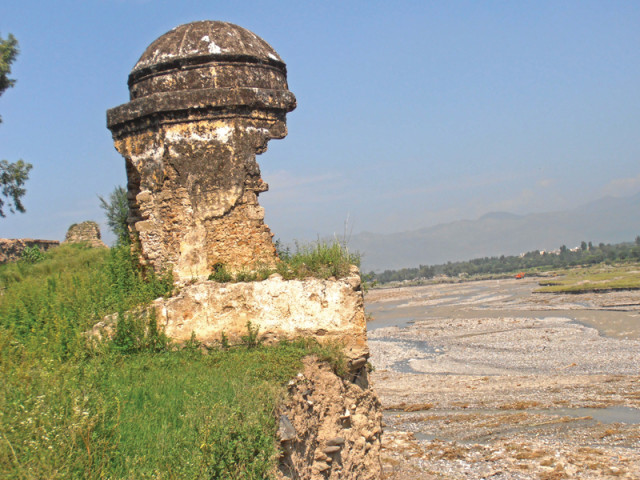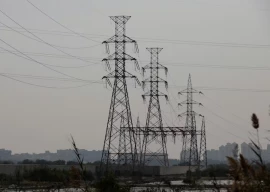
Considered by many to be an ancient Buddhist stupa, a dome-topped monument in Dheri Sikandarpur is on the brink of collapse. The possibly historically valuable stupa is not listed as a protected site and has been eaten away by years of erosion caused by River Daur. Locals maintain the stupa might not exist after the next monsoon season if no protective measures are taken.
The site is located half a kilometre from Haripur and overlooks the river. It is perched on a height of 300 feet. The structure is 12 feet high and six feet wide.
Disputed origins
Qasim, a retired educationist better known as Comrade Qasim, said the monument is a Buddhist stupa presumably built around the same time as ancient Taxila, which is now a Unesco world heritage site. The presence of Buddhist sites in other parts of Haripur district such as Panj Katha in Khanpur town confirms his theory, he added.
“Another stupa near the site was swept away eight years ago when River Daur overflowed its banks,” he said. “Nothing was done to restore the monument even though there is a law that requires ancient sites to be preserved.”
According to a series of anecdotes heard from Qasim’s father, Hakeem Abdus Salam Hazarvi—a freedom fighter during the British Raj—Buddhist monks would congregate at both monuments to pray.
However, Riaz Hussain, a resident of the village, has pointed out an alternative history for the monument.

The monument is considered to be a Buddhist stupa which some presume was built around the same time as ancient Taxila, which is now a UNESCO world heritage site. PHOTOS: MUHAMMAD SADAQAT/EXPRESS
The stupa is located near another historical site; the Harkishan Garh Fort, which was built by a Sikh general named Sardar Hari Singh Nalva during 1822-23. As a result, Hussain believes it could have been used by Sikh guards as a watchtower to observe activity on the other side of the river or to monitor the water distribution system to different villages.
With just one look at a photograph of the stupa, Dr Shakirullah, an assistant professor at the archaeology department in Hazara University, deduced it dates back to the 18th or 19th century. Ancient Taxila roughly dates back to the 5th century BCE, according to Unesco’s world heritage convention website.
“The use of Waziri bricks with lime mortar and thick lime plaster suggests it was built during the Mughal era,” he said.
According to Dr Shakirullah, the monument could have been a watchtower. However, he said his team would have to visit the site to conduct further investigation and determine the origins of the monument. His team will take up the matter with K-P’s archaeology director and ensure that preservation work begins on the site, said the assistant professor.
Source of life and destruction
The origins of the monument might be undetermined as yet but that should not stop the government from identifying which era it was constructed in. It also does not mean the stupa cannot be preserved; nearly half of it has been eviscerated by time and climate and is in desperate need of an overhaul.
In fact, the stupa is still at risk as erosion caused by the heavy flow of River Daur poses a significant threat to the monument.
River Daur serves as a perennial source of water for agriculture.
However, the absence of proper embankments has caused a significant attrition of the landmass beneath the monument in addition to sweeping away hundreds of acres of land. Private landowners have built walls to protect their land as opposed to the monument which no one, not even the government, lays any claims to.
Sardar Muhammad Rafi, a social activist and the president of Sikandarpur Village Organisation said Raha, a UN-sponsored organisation, has allocated Rs7.3 millions to construct a retention wall along River Daur. He added this move would not just protect vast acres of land eroded by the river but also the stupa from further deterioration. This would be good news if it
happens soon
“The monument won’t be able to withstand the next monsoon rains and will be swept away by the river,” said Farooq, a resident of Sikandarpur village. The archaeology department has mainly focused its attention on Taxila and ignored ancient sites in villages along River Daur, he added.
Published in The Express Tribune, September 19th, 2014.














COMMENTS
Comments are moderated and generally will be posted if they are on-topic and not abusive.
For more information, please see our Comments FAQ